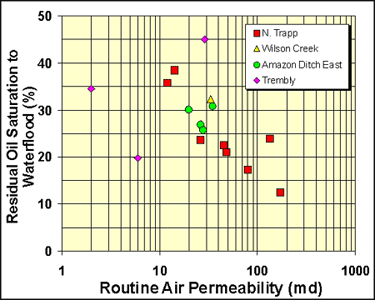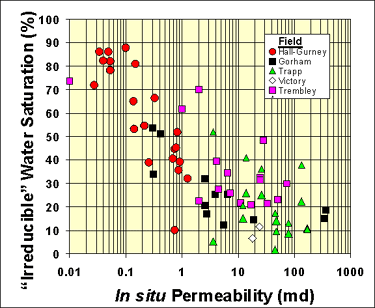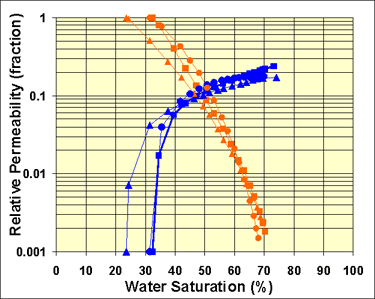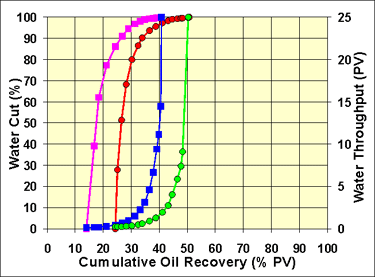 |
Oomoldic Reservoirs of Central Kansas, Controls on Porosity, Permeability, Capillary Pressure and Architecture |
Kansas Geological Survey Open-file Report 2002-48 |
Residual Oil Saturation to Waterflood
 |
Comparison of residual oil saturation to waterflood (Sorw) for samples from several fields indicates that Sorw increase with decreasing permeability. This may be related to the fact that low permeability rock may still contain large oomoldic pores. High pore body-to-pore throat size ratio has been show to be a strong control on snap-off phenomena and would be expected to result in trapped oil in the large oomoldic pores. Residual oil saturation can be predicted using the relation:
|
“Irreducible” Water Saturation
With finer pores in the matrix surrounding large oomolds it is important to understand capillary pressure relationships since high porosity may not be directly associated with effective oil porosity. Correlations of “Irreducible” water saturations (measured at pressures equivalent to 60-120 feet above free water level) indicate that Swi increases with decreasing permeability as exhibited by many rocks. Differences between fields are largely attributable to the samples/wells analyzed and may not reflect true field differences.
Saturation increases with decreasing permeability following the relation:
Swi = 35.7 exp(-0.46 log k)
where Swi is in % and k in md.

Relative Permeability
Imbibition relative permeability curves for oomoldic limestone samples from the Amazon Ditch East Field, Marmaton Formation, exhibit uniformity for three similar samples exhibiting porosities from 24.0 to 25.3%, and permeability from 19.8 to 27.5 md.

Waterflood Susceptibility
Calculated waterflood susceptibility curves for oomoldic limestone samples from the Amazon Ditch East Field, Marmaton Formation, exhibit recovery efficiencies ranging from 56.2 to 66.3% of the oil in place (38.5-50.7% of pore space). These recoveries are for the similar samples exhibiting porosities from 24.0 to 25.3%, and permeability from 19.8 to 27.5 md. The moderately high recovery is consistent with recoveries exhibited by better Lansing-Kansas City oomoldic limestones but many lower permeability rocks exhibit poorer recovery efficiencies.

e-mail : webadmin@kgs.ku.edu
Last updated March 2004
http://www.kgs.ku.edu/PRS/Poster/2002/2002-48/P3-05.html